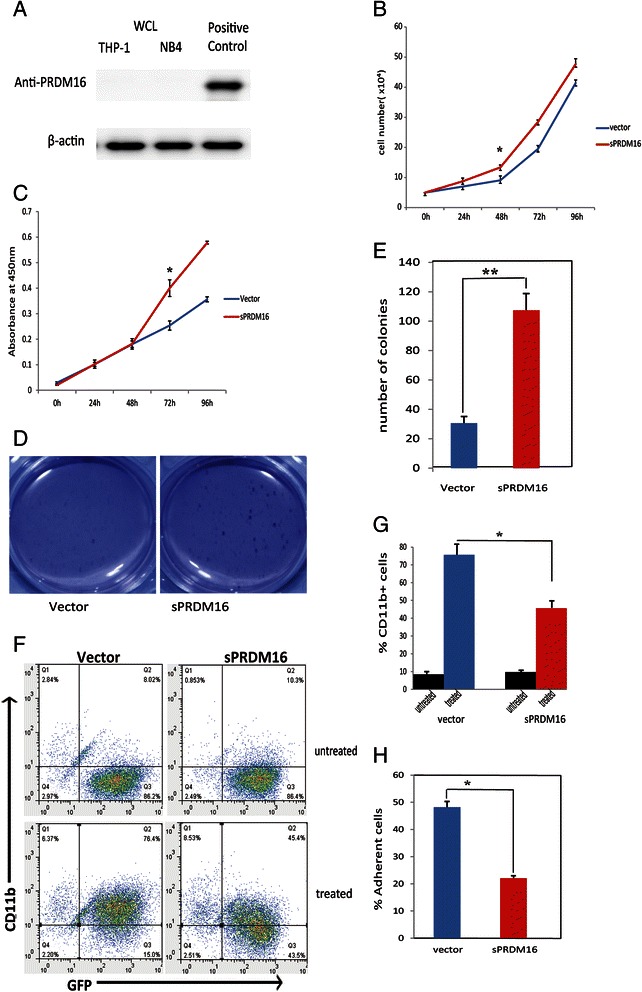Fig. 1.

sPRDM16 promoted the proliferation, enhanced the capacity for self-renewal and inhibited the differentiation of acute myeloid leukemia cells. a Protein levels of sPRDM16 in THP-1 and NB4 cell lines. The original whole-cell lysates (WCL) were analyzed by immunoblotting (IB) with anti-PRDM16 or anti-actin antibodies. b Overexpression of sPRDM16 promoted proliferation of THP-1 cells. THP-1 cells stably transfected with either vector (Vector-THP-1) or sPRDM16 (sPRDM16-WT-THP-1) were cultured and cell number was counted at the indicated time. Data are presented as mean ± S.D. of three independent experiments in RPMI-1640 medium. The number of vector and sPRDM16 differed significantly at 48 h (P < 0.01). c Proliferation of the THP-1 cells was determined using CCK-8 assay. The absorbance of the CCK-8 assay solution was detected with plate reader (450 nm filter). Data are presented as means ± S.D. of three independent experiments. Difference between two cell lines was significant at 48 h (P < 0.01). d Overexpression of sPRDM16 increased colony formation of THP-1 cells. THP-1 cells stably transfected with either vector (Vector-THP-1) or sPRDM16 (sPRDM16-WT-THP-1) were seeded in 1 ml of medium containing 10 % FBS with 0.35 % soft agar at 1 × 103 cells per well and layered onto the base soft agar medium. The photographs were taken after 12 days. Images are representative of three independent experiments. e The number of colonies in colony formation assay was scored after 12 days. The colonies were visualized by staining with 0.5 % crystal violet. The experiments were analyzed in triplicate and colonies larger than 50 μm in diameter were counted under microscope. Columns, mean of triplicate experiments; bars, S.D. An unpaired (equal variance) t-test was performed to compare sPRDM16–WT and vector control (* * P < 0.01). f Overexpression of sPRDM16 suppressed differentiation of THP-1 cells. Logarithmically growing cells were exposed to 3 nM PMA for 24 h. The percentage of cells expressing the monocytic maturation marker CD11b was determined by flow cytometry. The results are representative of three independent experiments. g The results of flow cytometry were represented as a histogram. Values represent the mean ± S.D. for experiments performed in triplicate. *P < 0.01 represents a significant difference from the cells treated with PMA (n = 3); columns, mean of triplicate experiments; bars, S.D. h The same THP-1 cells were treated as E. Logarithmically growing cells were treated with 3 nM PMA for 24 h. The percentage of adherent cells was calculated. Values represent the mean ± S.D. for experiments performed in triplicate. *P < 0.01 represents a significant difference from cells treated with PMA (n = 3); columns, mean of triplicate experiments; bars, S.D.
